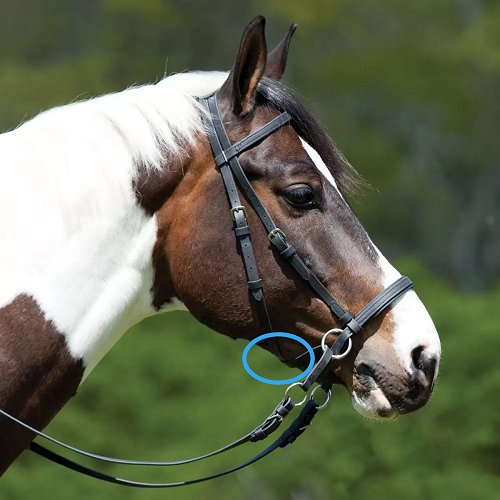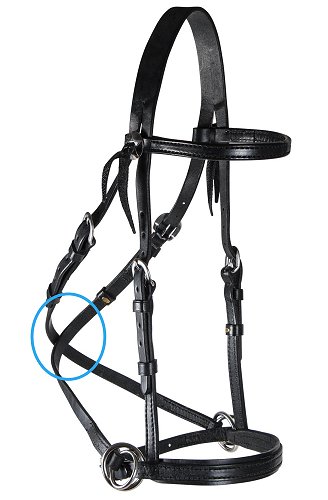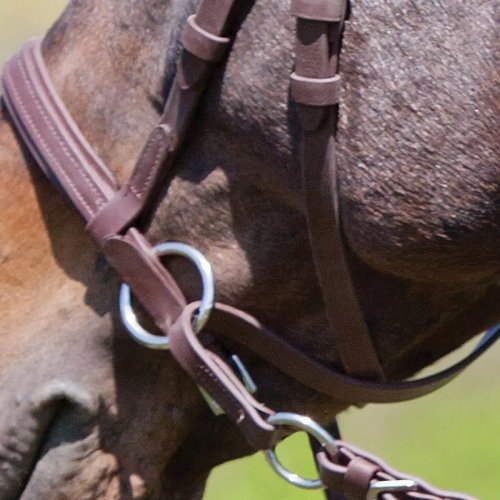Bitless Bridle
“Less pain means more brain”
 The bitless bridle is slowly becoming popular – particularly among natural horse trainers and western riders. However, it is not yet accepted by all disciplines (much like barefoot horses). The world of horse training is very slow to change, and many, many riders equate the bit with absolute control. None of my horses routinely wear bits, but (while selling 5 horses) I met only one prospective buyer who wanted to try the horse without one. I had to do a lot of demonstrating and explaining to get through.
The bitless bridle is slowly becoming popular – particularly among natural horse trainers and western riders. However, it is not yet accepted by all disciplines (much like barefoot horses). The world of horse training is very slow to change, and many, many riders equate the bit with absolute control. None of my horses routinely wear bits, but (while selling 5 horses) I met only one prospective buyer who wanted to try the horse without one. I had to do a lot of demonstrating and explaining to get through.
Unlike a bit, whose pressure is tightly targeted to sensitive areas of the horses face and mouth and based solely on pain, the quality of pressure of the Bitless is firm and spread out over the entire head from rein to poll. Critical to the design is that the reins are “crossed” under the cheek so travel from the loop, under the jaw, over the opposite side of the poll and back down to the noseband on the opposite side.
If the reins are used in a two-handed fashion, pulling left will put broad pressure on the right side of the face and head to firmly bring the head left. If used to neck rein, then pushing the right rein left over the neck will firmly pressure the left side of the face, bringing the left side around. (It goes without saying that your horse must understand how to give to pressure. See the articles on Pressure and Flexing). Also brush up your leg cues. More cues mean faster understanding.
It encourages the turn or stop without causing the fear, flight, fight, or freeze response. It can transmit the most subtle of cues without the risk of triggering adverse reactions that get in the way of thinking and understanding. A horse in the throws of “fight” or “flight”, is certainly not in the whole game with you. Horses will cooperate or even “participate” if they have a chance to figure out what you want. My motto is “Less pain means more brain”.
Stopping is a matter of putting pressure to both reins, which initiates a firm squeeze to the whole head and face from poll to cheeks to bridge of the nose. Unlike pain-based-pressure, the Bitless depends on a calm “hugging” of the face and controlling it gently. Once you free your horse from fear, you get more trust, more cooperation, and more harmony between you and your horse. Gait, collection, and performance also improve as tension and breathing obstruction disappear.
 It can solve a myriad of problems – some that people don’t even associate with a bit – such as:
It can solve a myriad of problems – some that people don’t even associate with a bit – such as:
1. Horses who are hard to bridle or un-bridle or hard to mount. It doesn’t take a horse long to realize that the insertion of the bit is the first stage of having his mouth hurt. I have seen horses who begin to throw themselves backward at the hitching post when they see the saddle – before they even see a bit. Usually their owners think it is because of the saddle or sore feet or anything but the bit. Really smart or often-ridden horses begin to anticipate many steps ahead of the problem and know that the saddle comes just before the bit.
2. Poor mounting practices can be mitigated. Mounting is frequently accompanied by a rein jerk (to keep him from walking off). How many horses have you seen who walk off and get their heads snapped up by the bit. How does a bit feel during that procedure? After implementation of the Bitless bridle and a couple of flexes at the mounting block, most of these horses stop the “leaving” behavior and bring their heads down. They calm down.
3. Horses who don’t relax into gait (forever waiting for the painful “whoa”). It is hard for a horse to gain confidence moving forward smoothly if every time he starts to relax, a man-handling trainer jerks him to a stop or slams him into a turn using his mouth. Hair-trigger responses to hand cues that he anticipates will be painful cause his gait to be jerky and stiff. Turns accompanied by neck tension, head throwing and resistance are very often the result of bit-trauma. Additionally, bits can interfere with breathing. Since a horse’s gait is synchronized with his breathing (one breath for every stride), anything that shortens his breath, shortens his stride.
4. Horses who travel with excessive saliva or open mouths.
There is some controversy about salivation when it comes to bits (especially about excessive salivation). The adage is that, “A salivating horse is a more relaxed horse”. He is thought to be moving his tongue and relaxing his lower jaw while relaxing the two most important muscles of his neck. However, Dr Cook of Bitless Bridle fame feels that because a horse can either swallow or breathe (but not both at the same time), stimulating his salivary response happens in conjunction with drawing his tongue back in preparation for swallowing and partially cutting off his airway. A horse with diminished air cannot perform to his maximum capacity.
Many disciplines want salivating horses, believing that a moist mouth lubricates the bit and a salivating mouth shows jaw relaxation. I have not had experience in those disciplines, but I have seen dressage horses whose whole attitude, demeanor and collection have improved DRAMATICALLY – during the first experience with a Bitless Bridle. My experience with taking the bit out of the mouth has also demonstrated that “no-bit” has cured many problems. Lubricating a bit is unnecessary if there isn’t one. And jaw relaxation is always achieved when the stress is taken from the mouth.
5. Fidgeting. You want a calmer horse who gives you better attention. Your horse should be focusing on your subtle cues, not how to avoid his bit. If you have done the ground work properly, you have many cues for maneuvers that do not require the bit. Leg cues with seat cues should suffice for nearly every maneuver. A gentle reminder to change his head position coupled with the other cues is all it takes.
6. Refusal to go forward or backing-up. This can be related to pain while in forward motion whenever a hand cue is given. Backing up is never solved by a bit. When re-training to the Bitless, take care not to ask for too many turns and stops in a small space or short time. Let your horse relax into his new headgear and you will find him more willing. After he learns to understand your new “feel”, he will be even more responsive in a whole new way.
7. Bolting or throwing his head up during the stop or the back. It goes without saying that a horse whose mouth is being pulled or jerked will try to avoid the pull in any way possible. Bits cause fear. Fear can cause flight. Flight is the definition of a horse who will not stop. Many horses who bolt receive even harsher and harsher bits when the opposite is often the answer.
8. Many, many more problems caused by your horse’s anticipation of pain when ridden.
If you have a real problem or unmanageable horse, you should introduce the Bitless in the round pen and re-train all exercises until you see a calmer, happier horse. My bet, just a day or two. Then move to the larger arena. Then to the trails if that is your goal. Both you and the horse need to gain confidence using it. You will want to be sure you feel confident he will not bolt or get away from you. The horse needs to get over his bad experiences and adopt a new, relaxed attitude (that takes considerable time if he is bit-traumatized – like PTSD).
 The Bitless is also an excellent tool for teaching neck reining. (I think it was originally developed for that reason and then found to have many other wonderful results). And starting a young horse in this type of head gear is a much better introduction to working for a living. It gives horse and trainer a chance to develop trust and confidence without any of the negative problems associated with bit-aversion. If he must use a bit in competition, you can transition to a bit later in his training when you have perfected your other cues and do not depend on your hands to “man-handle” his face. The test of a good rider is his ability to employ a bit with no adverse effects or behaviors. The inventor of this type of bit rightly asserts that, “If a horse resists a bit, this exposes a weakness of the bit as a method of communication, as it is a method that only a master horseman can use without causing a horse discomfort”. How many “master horsemen” do you know?
The Bitless is also an excellent tool for teaching neck reining. (I think it was originally developed for that reason and then found to have many other wonderful results). And starting a young horse in this type of head gear is a much better introduction to working for a living. It gives horse and trainer a chance to develop trust and confidence without any of the negative problems associated with bit-aversion. If he must use a bit in competition, you can transition to a bit later in his training when you have perfected your other cues and do not depend on your hands to “man-handle” his face. The test of a good rider is his ability to employ a bit with no adverse effects or behaviors. The inventor of this type of bit rightly asserts that, “If a horse resists a bit, this exposes a weakness of the bit as a method of communication, as it is a method that only a master horseman can use without causing a horse discomfort”. How many “master horsemen” do you know?
When purchasing a Bitless Bridle, purchase a nylon or leather. I do not like the “rubbery” type. They tend to be a little sticky and stretchy for precision timing.
I believe that you will find this new headgear a real benefit. Since the horse is being “hugged” instead of hurt, trust has not been breached, and he has not being punished. He can concentrate better and give more attention to your other body cues for all maneuvers.
We certainly don’ t know everything. Please share your expertise and experiences. Comment on what is already written or Suggest a Category and Educate us about it. Grow Horse-Pros.com©
That’s a nice article!!!
But the pictures aren’t as good. The last one isn’t a “hugging bitless bridle” type of bridle (actually, rope and knot noseband can be quite harsh), and the bridle in the first picture isn’t assembled in a hugging manner either – it seems to be putting a massive pressure over the poll, since it’s going straight from reins to poll instead of crossing under the jaw (which would give it a larger area to spread this pressure).
HI Laura: Thanks for weighing in. I have found some new pictures of the regular bitless bridle used correctly. (I hope that SmartPak won’t mind if we give them a link here.) If you have any pictures of your own that you would like to share, let me know. I would love to post them
I will take off the “side-pull” bitless-bridle picture that was meant to transport the reader to the sidepull page. It seemed to be confusing. It isn’t really a “classic” bitless bridle. It is more a “halter” than a bridle and does not work on the same principles as the “bitless” that has become so universal.